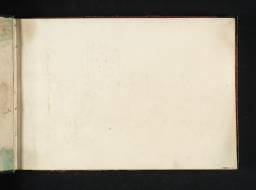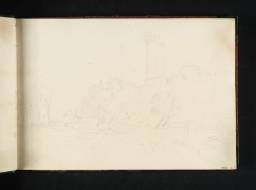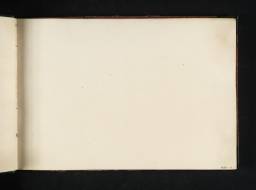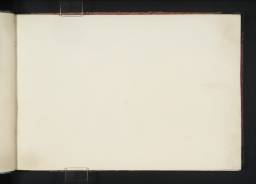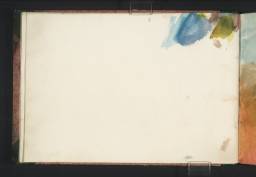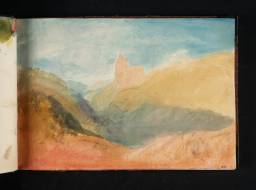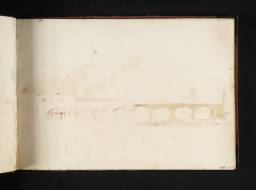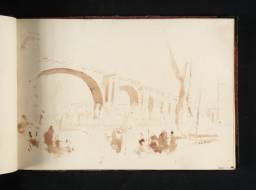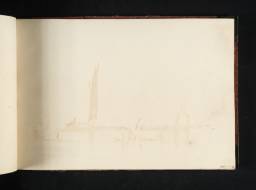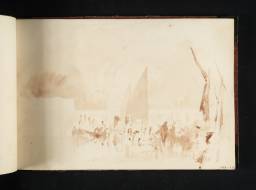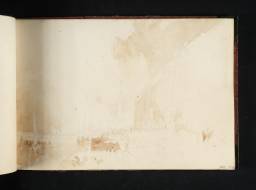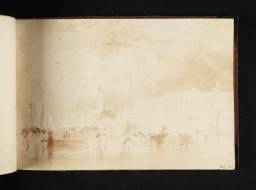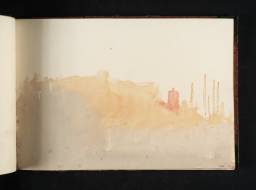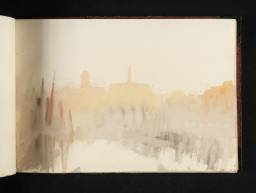Turner Bequest CLXX
Quarterbound sketchbook bound in paste paper covered boards in mottled pink, with dark-green leather spine and corners. The front cover is inscribed in pencil ‘S45’ at the upper right, stamped in black ‘CLXX’ at the top right, and blindstamped with the Turner Bequest stamp on the leather spine cover at the upper left.
Turner’s paper label is pasted to the spine and carries his inscription in black ink ‘109’ (D40885).
The inside front cover is inscribed in pencil ‘S45 6/6 | 60’ at top left, ‘S45’ at the top right, and in pencil by ?John Ruskin ‘8 ¾ by 6 Scottish Antiquities’ at the top centre left. It is blindstamped with the Turner Bequest stamp at the upper centre, inscribed in pencil ‘CLXX’ at the top centre, and stamped in brown ‘CLXX’ at the upper left.
Numbered ‘306’ as part of the as part of the Turner Schedule in 1854 and endorsed by Turner’s executors on the inside front cover in brown ink by H.S. Trimmer ‘No 306 Contains 13 leaves in Pencil | Indian Ink + Colour | [signed] H.S. Trimmer’ upper centre, with Charles Turner’s signature ‘C Turner’ beneath this in brown ink, and the signed initials of Charles Lock Eastlake ‘C.L.E’ and John Prescott Knight ‘JPK’ in pencil beneath.
43 leaves of off-white heavyweight wove drawing paper made on a double-faced mould by William Balston at Springfield Mill in Maidstone, Kent. Watermarked ‘J Whatman | 1815’ on folios 1, 2, 5, 8, 10, 11, 15, 16, 40 and 41 (D13814, D13815, D13824, D13825, D13829, D13830, D13854, D13855; CLXX 1, 2, 4, 7, 9, 10, 14, 15, 39, 40)
Approximate page size 177 x 256 mm
Turner’s paper label is pasted to the spine and carries his inscription in black ink ‘109’ (D40885).
The inside front cover is inscribed in pencil ‘S45 6/6 | 60’ at top left, ‘S45’ at the top right, and in pencil by ?John Ruskin ‘8 ¾ by 6 Scottish Antiquities’ at the top centre left. It is blindstamped with the Turner Bequest stamp at the upper centre, inscribed in pencil ‘CLXX’ at the top centre, and stamped in brown ‘CLXX’ at the upper left.
Numbered ‘306’ as part of the as part of the Turner Schedule in 1854 and endorsed by Turner’s executors on the inside front cover in brown ink by H.S. Trimmer ‘No 306 Contains 13 leaves in Pencil | Indian Ink + Colour | [signed] H.S. Trimmer’ upper centre, with Charles Turner’s signature ‘C Turner’ beneath this in brown ink, and the signed initials of Charles Lock Eastlake ‘C.L.E’ and John Prescott Knight ‘JPK’ in pencil beneath.
43 leaves of off-white heavyweight wove drawing paper made on a double-faced mould by William Balston at Springfield Mill in Maidstone, Kent. Watermarked ‘J Whatman | 1815’ on folios 1, 2, 5, 8, 10, 11, 15, 16, 40 and 41 (D13814, D13815, D13824, D13825, D13829, D13830, D13854, D13855; CLXX 1, 2, 4, 7, 9, 10, 14, 15, 39, 40)
Approximate page size 177 x 256 mm
Accepted by the nation as part of the Turner Bequest 1856
Exhibition history
References
Turner used only fifteen pages from this book for a mixture of sketches and studies in pencil and watercolour. Finberg has dated these to 1818–20 which seems likely as the earliest studies in the book, those of Borthwick Castle (folios 1 and 2; D13814, D13815; CLXX 1, 2), were certainly executed around the end of 1818 or beginning of 1819. These were based on sketches executed in Scotland in October–November 1818, from which he had returned by 1 December, and were preparatory to a watercolour which seems to have been completed before 25 January. (See folio 2 for more information on these dates). The later studies in the book, of London Bridge, must have been executed before 1824 as that was when building work began on the new London Bridge as can be seen in sketches by Turner in the Old London Bridge sketchbook of that date (Tate D17848; Turner Bequest CCV 8). A date around 1820 may be likely for these sketches as it was in July of that year that W.B. Cooke commissioned Turner to paint views of London for a proposed part-work project, to which some of these sketches relate.
Sketches of Waterloo Bridge, and the Custom House with London Bridge were executed in pencil and sepia-coloured watercolour wash, and were likely to have been made on the spot from the banks of the Thames. These may have been connected with W.B. Cooke’s aborted print series Views in London and its Environs.1 A watercolour, probably intended for this series, The Custom House, London Bridge, circa 1825 (Vancouver Art Gallery),2 was engraved by the project’s engraver J.C. Allen and was based on sketches in this book.
The Borthwick studies, and a colour study of Crichton Castle (folio 5; D13818; CLXX 4), were made in preparation for watercolours to be illustrated for The Provincial Antiquities and Picturesque Scenery of Scotland, a series of engraved topographical views of Scotland with descriptions by Walter Scott (see Tour of Scotland 1818 Tour Introduction). Both were based on sketches made during Turner’s recent to the country shortly beforehand.
Finally there is a page of diagrams that have been connected with Turner’s teaching as Professor of Perspective at the Royal Academy. These may relate to his 1819 lectures (see folio 5 verso; D13819; CLXX 4a).
Finberg called this sketchbook ‘Scotland and Venice’, misidentifying two sketches of the Thames with the Custom House and London Bridge and St Paul’s Cathedral in the background (folios 12 and 43; D13826, D13858; CLXX 11, 42) as ‘the Canale di S. Marco, Venice’ with St Mark’s cathedral.3 He may also have been misled by the figure of a lighterman steering a barge with a paddle (folio 12) that somewhat resembles a gondolier. The mistake was apparently first noticed by C.F. Bell, who noted the correct identifications in his copy of Finberg’s Inventory.4 The book was renamed ‘Scotch Antiquities and London sketchbook’ in the 1974 Royal Academy exhibition catalogue, Turner 1775–1851, but the name, ‘Scotland and London’, has been more frequently used.
Technical notes
How to cite
Thomas Ardill, ‘Scotland and London sketchbook 1818–20’, sketchbook, August 2009, in David Blayney Brown (ed.), J.M.W. Turner: Sketchbooks, Drawings and Watercolours, Tate Research Publication, December 2012, https://www

